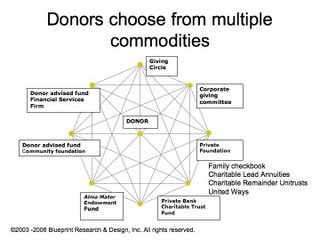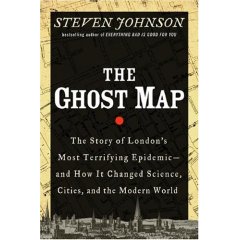Social Network Philanthropy - this is it
Here it is - social network enabled decision making for grantmaking - smartocracy.net
Bookmark this on Del.icio.us
Research, analysis, and provocation on future directions for philanthropy
Here it is - social network enabled decision making for grantmaking - smartocracy.net
The San Francisco Business Times reported (August 28, 2006) that$4.5 bb in giving was recorded in 2005. Much of this was disaster related. More than 1/3 of giving for the tsunami and about half of all Katrina-related giving happened online.
The September 2006 issue of Nonprofit and Voluntary Sector Quarterly has a bevy of articles for foundation-watchers. Full article access is limited to subscribers or single-use purchases, but you can read the abstracts online. I recommend the following pieces (links are to abstracts):
Hivos is a Netherlands-based NGO. Its virtual office offers a nice example of one way funders can manage their application processes and share information with potential grantees that might actually make their lives easier.



... has been the most common response to the posting I did on the Voices and Choices Program.
Michael Gilbert's has provided an analysis of a survey he conducted on using RSS to stream grantmaking data. He notes impressively high interest rates (greater than 70% of respondents, with or without grantmakers themselves in the mix). Here is the link to the paper from Gilbert on why he thinks this is a good idea.
The "future of futurism is bright."

...or at least a virtual class from Harvard Law School. Professors at the School will offer a class in Second Life. See the announcement for the CyberOne Course. This takes online curriculum, distance learning, and open courses to a whole new...well, life.
Today's Wall Street Journal points out that people can be as greedy about "points" as about any other currency. Just as "ClickFraud" plagues advertising vendors and buyers, the ease with which online experts can falsely inflate their "rated" expertise by loading up on easy questions (or simply repeated questions) is now beginning to plague sites like Yahoo Answers.
I know this isn't a tax column, but tax policy in the U.S has a lot to do with philanthropy, so bear with me. David Cay Johnston of the New York Times is the only person I know of who can make tax reporting interesting. His piece in Sunday's paper was not only interesting, I had one of those "Jump out of the chair shouting You've gotta be kidding" moments.
Seth Godin has a live posting of web 2.0 sites, showing popularity, change in ranking and all things traffic related. Talk about metrics.
...But instead it came via email.
or blog, as the case may be. I asked when social networking philanthropy would arrive. Here it is, Voices and Choices in Ohio - a project of a funders collaborative, an organization specializing in collaboration and a university partnership. Thanks to a friend for sending this my way
Social network investing is taking off. See this article from TechCrunch that highlights several social network stock picking sites.
Social network investing is taking off. See this article from TechCrunch that highlights several social network stock picking sites.
Social network investing is taking off. See this article from TechCrunch that highlights several social network stock picking sites, including SocialPicks.
I've been tracking complementary currencies, alternative ways of mobilizing folks, and new developments in philanthropy. Add social-networking enabled microloans to the list, courtesy of Kiva.
Once again, David Bollier has pointed me to something cool. Awhile back I wrote about complementary currencies - here's on called BookMooch. I've been a member of PaperBackSwap for more than a year - BookMooch is similar in purpose - to help those of us who have more books than money trade what we've read for that which we covet (my words, not BookMooch's or PaperBackSwap's).
I'm completely intrigued by the idea of complementary currencies. The most familiar of these are things like membership reward points, frequent flier miles, or time banks. Reimagining Money has a wonderful resource list of information about complementary or innovative currencies. Here's a database and map of complementary currency initiatives.
Most philanthropic conferences as you to first prove that you are qualified to attend (e.g. you work at or are on the board of a foundation). Here's a different approach - the Investor's Circle conference, Patient Capital for a Sustainable Future, sent me an invitation and explicitly asked that I "Spread the word. Share. Post. Forward. Print."
IBM has opened up its annual Innovation Jam to the public. It says it will put millions of dollars behind the best ideas generated. Philanthropy should a) either try this or b) grab some socially productive ideas from the IBM Jam.
Byron Wien of Pequot Capital (formerly chief strategist at Morgan Stanley) is reknown on Wall Street for his annual list of "ten surprises" which he has released every year in January since the mid-1980s. Here's his 2005 list. Here's an article he wrote on philanthropy back in 1997 for the TIFF Education Foundation. I always like to go back in time and this essay gives us a "before the boom" perspective on some now-common ideas in philanthropy, such as venture philanthropy or donor as investor.
"Ninety-nine percent of the $14.6 billion raised by nonprofits in auction in 2005 was raised offline." (Forbes, August 14, 2006, P. 105)
I found MobileActive.org at Smartmobs, Howard Rheingold's blog on collective activity. Since my last post is about the old fogies among us (myself included) mobileactive is for the rest of you - using cell phones to organize people to organize change.
We all know that America is getting older. Every day - every 24 hours - 10,000 people turn 60 and another 7,918 turn 50. So, naturally, as baby boomers have done all their lives, this age group is attracting businesses, products, and marketing. Here's one: Eons. In a Time Magazine story about Eons Daniel Kadlec focused in on the website's longevity calculator, using it to see what dietary changes he might make to boost his chances of living to be 96.
Foundations and the philanthropy industry are spending a lot of time looking for metrics. Investors and the financial services industry have tons of metrics. The news industry (in all its media forms - papers, TV, radio, magazines, blogs) is full of data and analysis on those financial services metrics.


C/NET and The Onion have come up with this satire about the U.S. Government's response to the growth of the Bill and Melinda Gates Foundation.
Community foundations are (at least in the US) partially defined by their commitment to a community defined by geography. Some of them are defined exclusively this way, such as the Ocean Foundation, The Sierra Fund, the Colorado Conservation Trust, and the Alaska Conservation Foundation. These are not just placed-based community foundations, they are community foundations for places - water, mountains, and the open space of Colorado and Alaska, respectively.
And here is another NYT story, this one on starting a concert at a time other than 8 pm (shocking!).
In this story in today's New York Times we learn that even the reference librarians don't know how to use the classification system in the main reading room. Using a categorization system developed by the Library's director from 1896-1913, today's librarians have developed all sorts of workarounds, including maps, to help them find something among the room's 25,000 resources. The general public is on their own - although frequent users claim to have memorized where things are (not much use for a first timer).
The second post I ever wrote for this blog, on July 9, 2002, was about foundations and pending regulatory reform. And now it is finally here. As we go forward in the short term we can stop wondering about "pending changes" and start looking for the implications of "reforms".
Thanks to a public health doctor friend who forwarded to me this opinion piece in The Toronto Star. Raising issues of control, public subsidies for tax-exempt dollars, and the lack of public input, Anne-Emmanuelle Birn offers an opinion on the Buffett-Gates Gift. According to the listserv from which this came, this opinion piece was rejected by over 30 US papers before being accepted by the Star.
Community foundations all over the world are trying to connect with their communities. They are trying to structure themselves to serve customers (communities and donors) who have an abundance of choices and options of places to go to get everything a community foundation offers. So why should they come to the community foundation?
Local newspapers are dying. Local philanthropy is booming. At least these are the myths we live by. Let us imagine they are true.
Today's papers are filled with pictures of airport bins overflowing with confiscated shampoo, bottled water, lipstick, toothpaste. etc. There also were lots of stories about empty Duty Free Shops since most of what they sell is liquid, and thus wasn't allowed on the planes.
Everyone always wishes they could predict the future. Some folks are better than others at identifying elements of the future that are sure to change. Two such folks, Seth Godin and Eamonn Kelly have lists available. Here's Godin's Manifesto "Polkas, Pyros and Point Ds" from ChangeThis).
I got a request a while back for my list of philanthropy blogs. (Sorry for not responding sooner). In addition to the list on the right hand column of this blog (scroll down a bit), here's a list from the Wilson Center at Pace University. Charity Blog Network also has a list.
Some practical advice, and easy explanations, of web 2.0 stuff and how to use them for good. From Marnie Webb of CompuMentor.
Here's a role for foundations - spreading the good news about the environment as a means of changing the current debate which seems stuck in the mode of "going to hell in a handbasket, why doing anything."
The Tiger Woods Learning Center Foundation is issuing $10.78 million in municipal bonds through the California Statewide Communities Development Authority. This fundraising tool isn't available to every nonprofit but its popular for the bigger guys and not one that philanthropists think about too often.
David Bollier has taught me many things, the latest being this term, lingo-piracy. It has to do with the trademarking of common words used for uncommon purposes. In the story Bollier writes at On the Commons he notes the international community's use of Brazilian names for certain fruits. These words are used to name something else, trademarked, and then the trademarks enforced. When locals try to sell their produce (using its generic name) on the international market they get busted for trademark infringement.
The San Francisco Bay Area has long been one of the nation's richest in terms of community foundations - almost every coastal county from Mendocino to Monterey and inland to Solano has its own foundation. The region has thousands of nonprofits, thousands of donors, hundreds of staff, and billions of dollars in community foundation assets.
Social scientists, nonprofits, philanthropists and parents of school-age children love to argue about which metrics matter. For a real-time "conversation" about this, on a metric that seems inherently quantifiable at first (the number of blogs) check out this new State of the Blogosphere Report (and the comments conversation that follows it) on Technorati.
Bill Gates is getting a new job. That has thousands (or at least two that I know of) ex-Microsofties suddenly feeling competitive again. When John Wood, the Founder of Room to Read was interviewed by Deborah Solomon for The New York Times I noted the following exchange:
The US Senate passed a major pension reform bill late last week. Lots of groups worked hard on this effort, and, as Diana Aviv, President of Independent Sector noted in her email about it:
OK, maybe I'll never outgrow my school year calendar metabolism (27 years of formal schooling could do that to a person) but I've got September on my mind. O,f course it might have been caused by yesterday's newspaper - which was crammed with five pounds of back-to-school ads.
My previous post, which mentioned my interest in autism, led to a wonderful chat with a colleague. Justin reminded me of The Curious Incident of the Dog in the Nighttime - a fabulous story told from the perspective of a boy with autism. I was then reminded of Jonathan Lethem's brilliant novel, Motherless Brooklyn, about 3 inept crooks, one of whom has echolalia.
I wrote recently about the opportunities for community foundations and community newspapers to work together. I haven't heard much from community foundations on this, but the Gates Foundation just bought in as an investor to help a consortium buy four papers from the McClatchy newspaper chain.
Its August 4th - have you read anything wonderful yet this summer? I've filled my head with some great fiction (The History of Love, There Will Never Be Another You, Daniel Isn't Talking, Hummingbird's Daughter, The Natural, The Fixer, The Nimrod Flip Out, Intuition, Now is the Time to Open Your Heart, Roscoe) some serious nonfiction (The End of Poverty, Omnivore's Dilemma, Small Things Considered) and a whole lot of fiction and nonfiction about autism (a new fascination of mine).
If you add Freecycle (online exchange of anything) to Prosper (individual to individual lending) or Zopa (same) and DonorsChoose (donor directed online giving) does it add up to anything new?
The Rudolf Steiner Foundation and friends have launched the Reimagine Money project. Check it out here. Anything that reimagines philanthropy is OK by me. I like the resources on Complementary Currencies - an interesting idea to keep in mind when thinking about philanthropic systems
Pasted in below is the press release on the appointment of Emmett Carson to be CEO of the newly merged Silicon Valley Community Foundation.
Squidoo - yet another silly-new-name website company/tool hoping to become a verb (as in "to google") - is an additional example of how business, philanthropy, community, individual interests, and the internet can all be squished together.
Here at Gather.com (advertsied as MySpace for grownups)* is a conversation on philanthropy. Might we actually foster a discussion that crosses political opinions, old versus new philanthropy, venture versus traditional, social entrepreneurship versus charity? Or will all the new online tools and discussions (blogs, podcasts, wikis, social networking sites) break down along the same old useless lines that separate us in our "first life."**
We hear a lot of talk about accountability in philanthropy. Those "in the industry" or "inside the beltway" are lagging behind those who just watch - for liberal groups watching conservative philanthropists check out Media Transparency and for conservatives watching liberals check out Capital Research Center.